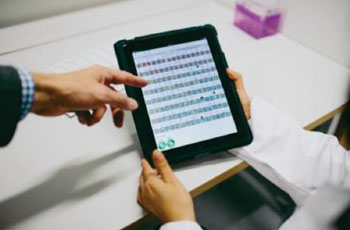Visual Recognition System Supports Malaria Diagnostics
By HospiMedica International staff writers
Posted on 04 Sep 2014
An innovative system uses computer vision algorithms, similar to those used in facial recognition systems, to provide a decision support system for diagnosing malaria infection. Posted on 04 Sep 2014
Developed by researchers at the Finnish Institute for Molecular Medicine (FIMM; Helsinki), the University of Helsinki (Finland), and Karolinska institutet (Stockholm, Sweden), the "man and machine" diagnostic aid digitizes and analyzes more than 50,000 red blood cells (RBCs) per blood sample, ranking them according to the probability of infection. The program then creates a panel containing images of more than a hundred most likely infected RBCs, and presents that panel to the user. Final diagnosis is by a health-care professional, based on the visualized images.

Image: Tablet computer used for visualization of diagnostically relevant RBCs. (Photo courtesy of Ari Hallami / FIMM).
During the testing phase, more than 90% of the infected samples were accurately diagnosed based on the panel. The few problematic samples were of low quality, and in a true diagnostic setting would have led to further analyses. When comparing the system to existing diagnosed samples, the researchers were able to show that the accuracy of the computer vision algorithms was comparable to the quality criteria defined by the World Health Organization (WHO; Geneva, Switzerland). The study describing the system and its testing was published on August 21, 2014, in PLOS One.
“The equipment needed for digitization of the samples is a challenge in developed countries. In the next phase of our project we will test the system in combination with inexpensive mobile microscopy devices that our group has also developed,” said lead author Nina Linder, MD, PhD, of FIMM. “There is also a strong need for fast and accurate methods for measuring the malaria parasite load in a sample. Various malaria drug screening programs are underway and the parasite load in a large number of samples needs to be quantified for determining the efficacy of potential drugs. We are further developing the computer algorithms used in this study to meet this need as well.”
According to the researchers, the developed support system could be applied in various other fields of medicine. In addition to other infectious diseases such as tuberculosis (TB), the research group is planning to test the system for cancer diagnostics in tissue samples.
There are more than 200 million new malaria cases yearly, and high-quality microscopy is still the most accurate method for detection of infection. Microscopy, however, can be very time-consuming, placing a heavy workload on trained health-care personnel, thus contributing to the demonstrably low accuracy of microscopy. As a result, less than half of the suspected malaria cases in Sub-Saharan Africa in 2012 received a diagnostic test.
Related Links:
Institute for Molecular Medicine Finland
University of Helsinki
Karolinska institutet














